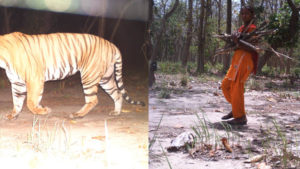Using Tiger Behavior to Make Conservation Smarter
While many big cats like tigers and mountain lions live in protected reserves and refuges, important wildlife corridors still exist in human-dominated areas. And if humans want to keep those wild cat populations intact, they’ll need to find more effective ways to share the landscape — particularly as cities and other human developments relentlessly expand.
A recent study looking at how tigers use landscapes that are also used by humans suggests that we could make use of the natural activity patterns of the big cats as a key conservation tool.

A camera trap reveals that a tiger and a woman collecting wood used the same forest in northern India, but at different times of day.
In an analysis published in the journal Conservation Biology, researchers at Colorado State University found that tigers, most active during dusk and dawn, take shifts with the people living nearby. In the Central Terai region of India, near the country’s northern border with Nepal, land managers maintain tall grasses and wetlands for tigers to shelter in during the day, freeing up forests for human use. When night falls, human access to the forest is restricted, allowing the tigers to roam freely.
Using camera traps to monitor trails and carrying out surveys on foot, the researchers found that forests used for logging support tiger populations that are similar in size to those living in protected areas set aside for large mammal conservation. Close to 3.3 million people live in villages just three miles from the tigers’ primary ranges.
“Their habitats are embedded in some of the most densely populated areas on earth,” says Pranav Chanchani, the lead author of the study.
The authors were critical of an earlier study published in 2012, which received wide media coverage, for “conflating ‘co-occurrence’ with ‘coexistence.’” They argued that the sites that study surveyed in Nepal’s Chitwan National Forest do not represent an area of high human disturbance, and that in any case, the fact that tigers and humans were sharing a landscape at different times of day does not imply the tigers are altering their behavior, as the earlier study suggested.
Rather, Chanchani and his colleagues argue that keeping tiger behavior and activity patterns in mind when managing mixed-use areas — many of which contain or connect to natural wildlife corridors —provides a more comprehensive conservation strategy for big cats, even when humans are heavily present.
“Our data reveal that tigers and humans can and do share landscapes. [However], there appear to be sharp thresholds of human use, beyond which tigers are precluded from an area,” he says.
Chanchani notes that the area where the study was conducted wasn’t conflict free. A single male tiger killed over 10 people from 2009 to 2010.
Still, the findings suggest that humans and big cats can share habitats successfully — albeit within limits.
According to the World Wildlife Fund, the global population of wild tigers has decreased by 97 percent over the last century. The organization estimates that as few as 3,200 of the animals exist today.
Even so, Chanchani says tolerance for tigers in India is higher than tolerance for mountain lions (also known as cougars, or pumas) in North America — even though, in the U.S. the species “do not pose a credible threat to humans.”
Seth Riley, a wildlife ecologist for the U.S. National Park Service, says his experience suggests that mountain lions and humans can coexist here, too. Near Los Angeles, millions of people live near mountain lions, he noted. And in over 16 years of working in the area, Riley says most people seemed to have positive attitudes about living near wildlife.
One mountain lion in particular has become famous for living in Griffith Park, in the middle of LA. The adult male cat, named P22, has his own Twitter and Facebook pages. He’s lived there for four years, hunting the park’s deer for food. However, most mountain lions in the region depend on protected areas.
Luke Hunter, president and chief conservation officer of Panthera, a nonprofit that is the only organization to focus exclusively on global big cat conservation, says that while we shouldn’t ignore multi-use areas, “the absolute backbone of any conservation plan for the tiger has to include these very well-protected national parks and wildlife reserves and refuges.”
Hunter was intrigued by the study’s finding that tigers had higher occupancy in multi-use areas than some protected areas. But occupancy — a broad measure of habitat use — is not the same as estimating the true number of big cats in a landscape. He says it’s possible that occupancy was lower in some protected areas because these tiger refuges act as obvious targets for poachers. In contrast, the presence of people in multi-use areas could have deterred poaching.
In that light, which habitat really supported higher numbers in the Central Terai landscape would seem to be unclear.
Still, Hunter said the study provided some interesting insights. “I think it raises a really important issue that would be worth looking at much more closely,” he said.










